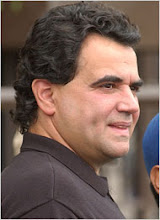
Oh yeah, sure they do care, somewhat. A horse has to be healthy to race and win money for them. Once it is apparent that a horse is "a looser" and not meant to race,.....thats when the slaughter part comes in, AND THAT was not even mentioned as an issue in their new "Task Force" recommendations. Not worthy of even a thought on the subject. Hummmmm.
Frum TheHorse.Com
by: Kimberly S. Brown, Editor
December 17 2008, Article # 13283
"We have a crisis in Thoroughbred racing," stated Scott Palmer, VMD, of New Jersey, a past president of the American Association of Equine Practitioners (AAEP) and head of the AAEP Racing Task Force.
The AAEP Racing Task Force was conceived in Austin, Texas, at the organization's Focus meeting because of the country's outcry following the catastrophic injury of Eight Belles. The result of four months of furious work is two white papers that will be presented to the AAEP board in January for approval. One will be an internal white paper for the organization's members, while the other will be released to the industry with recommendations of how to put the horse first in racing.
At the AAEP Convention's Racing Forum on Dec. 6, the membership went into closed session to discuss the recommendations of the task force.
In a later interview with Palmer, he said the task force will make recommendations to the AAEP board on four areas:
societal changes and the public perception of racing;
the business model of racing, and particularly those aspects of the current business model that may not be in the best interest of the horse;
the owner/trainer/veterinarian relationship that is broken and needs transparency; and
medication, which he said is hugely important.
He said in this "crisis" environment numerous safety commissions or task forces have been created, which he said was good, but he added that the AAEP felt that a veterinary perspective was needed, one which was based purely on the health and welfare of the horse.
"What is good for the horse is good for racing."
--Dr. Scott Palmer
"We have to put the horse first," he stated. "The horse is what makes racing different from all other forms of entertainment.
"What is good for the horse is good for racing," he emphasized.
Palmer said while the AAEP doesn't have the power to make changes throughout the racing industry, the task force members felt the AAEP could provide support to the people in the industry who can make the changes.
"We strongly support the efforts of others, like NTRA and The Jockey Club Safety Committee; we believe what we've done (the recommendations they will offer) will work hand-in-hand to make racing safer for the horse."
He said welfare and safety isn't a new initiative for the AAEP. "The AAEP was formed by a group of racetrack practitioners in 1954; we've been working toward this for more than 50 years," he said.
He noted there's a lot of "finger pointing" going on right now in the racing industry, "and we need to use scientific knowledge to see the big picture."
Palmer said many in the industry have been consulted in developing the task force's recommendations, including The Jockey Club, HBPA, sales companies, and racetrack owners.
"A number of these (forthcoming) recommendations involve considerable expense," said Palmer. "We don't expect overnight compliance, but we believe we have the support" to make the changes happen. "We anticipate the cost of the recommendations will be an obstacle that we'll have to address."
For example, in some jurisdictions within the United States approximately $200 is spent for drug testing of a racehorse, while in Hong Kong $700 might be spent per horse for more thorough testing.
There is a need to upgrade security and test racing surfaces, he said.
Palmer said there is now an opportunity to make changes in the business model of racing to reduce racing injuries, particularly in the way that claiming races are conducted.
Palmer said most veterinarians provide superior care of racehorses; others have created problems. The task force recommendations will address those problems. However, he stressed that medication is not just a veterinary problem, but an industry problem.
Palmer posed the question: Why are racehorses medicated?
The answers are:
to prevent disease (such as vaccination and deworming);
to treat illness; to treat an injury;
to minimize the disruption of the training schedule (the horse is headed for a particular race); and
to "level the playing field" when the owner or trainer thinks someone else has an edge.
The last two categories are driven by the business model of racing, and restructuring needs to take place to make sure that veterinary treatments are done with the best interest of the horse in mind, he said.
"We must put the horse first," he emphasized.
He said owner education is an important piece of the puzzle to address the problems of racing. "It's a complex puzzle, and if you miss one piece, it won't work," he said. "For example, you can't have uniform (medication) rules if you don't have uniform testing and administration.
"We have a great story to tell, but we can't 'spin' our way out of this crisis; we know we have problems, and we will address them."
--Dr. Scott Palmer
"The role of media is important," he said. "We have a great story to tell, but we can't 'spin' our way out of this crisis; we know we have problems, and we will address them."
The task force recommendations will focus on Thoroughbred racing, but many of the recommendations do apply to Standardbred, Quarter Horse, and Arabian racing as well, with the knowledge that there can't be a "blanket" approach, since each industry has unique problems and needs. Palmer added that some of the same issues that are faced by the racing industry apply to other performance breeds as well.
The AAEP is planning to conduct a welfare assessment of other competitive disciplines (such as three-day eventing) to evaluate the need for veterinary recommendations, said Palmer.
"We need commitment in all areas; we need meaningful change" in the racing industry, concluded Palmer.
http://www.thehorse.com/ViewArticle.aspx?ID=13283

















